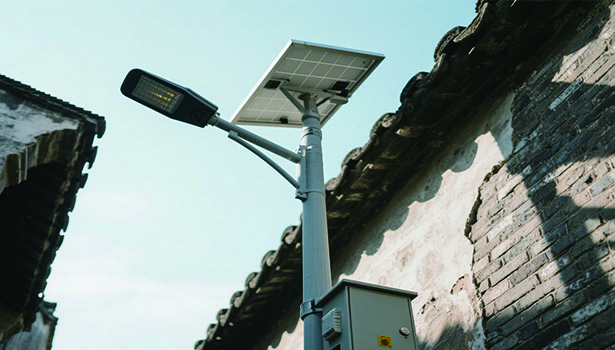The affect of High Temperature on Solar Street Light LiFePo4 Battery Life
Solar street lights, with their advantages of clean and environmentally friendly operation, easy installation, and low maintenance costs, have been widely adopted in various lighting scenarios such as urban roads, rural streets, and park pathways. Lithium iron phosphate (LiFePo4) batteries, known for their high safety, long cycle life, and stable low-temperature performance, have become the core component of solar street light energy storage systems. However, in high-temperature environments such as summer heatwaves and tropical/subtropical regions, LiFePo4 batteries in solar street lights often experience accelerated performance degradation and reduced lifespan, directly impacting lighting stability and operational costs. This paper delves into the specific effects of high temperatures on LiFePo4 battery longevity and proposes targeted mitigation strategies.

High Temperatures Accelerate Internal Structural Degradation of LiFePo4 Batteries
Significantly Increased Electrolyte Decomposition Rate
The electrolyte serves as the core medium for ion transport within LiFePo4 batteries, with its stability directly determining battery performance. Under high temperatures, the electrolyte undergoes accelerated decomposition reactions, producing gases and impurities. These decomposition byproducts adhere to electrode surfaces, disrupting the stability of the electrode-electrolyte interface. Simultaneously, this process increases internal battery resistance, accelerating overall performance degradation and shortening battery lifespan.
Accelerated Wear of Electrode Materials
The cathode (lithium iron phosphate) and anode (graphite, etc.) materials in LiFePo4 batteries undergo minor volume changes and structural degradation during normal charge-discharge cycles. Elevated temperatures intensify these processes, causing particle shedding and pulverization of electrode materials. This reduces the quantity of active material, ultimately diminishing the battery's energy storage and release capacity while accelerating aging.
High Temperatures Cause Permanent Capacity Loss
The capacity of a lithium iron phosphate battery refers to its maximum energy storage capability, a critical metric for ensuring continuous nighttime illumination in solar street lights. Under high-temperature conditions, battery capacity experiences a noticeable decline. Short-term exposure to heat may cause temporary capacity reduction, with some recovery once temperatures return to normal.
However, prolonged exposure to high temperatures causes irreversible degradation of the battery's active materials, resulting in permanent capacity loss. For instance, LiFePo4 batteries operated long-term at 45°C experience capacity degradation 2-3 times faster than those at 25°C. After one year, capacity may drop below 80% of initial levels, failing to meet solar street lights' extended nighttime illumination requirements.
High Temperatures Pose Potential Safety Risks
Increased Risk of Thermal Runaway
Although lithium iron phosphate batteries exhibit significantly better thermal stability than ternary lithium batteries—with a thermal runaway temperature (approximately 200°C) far exceeding that of ternary lithium batteries (approximately 120°C)—the risk of thermal runaway persists under extreme high-temperature conditions. When battery temperature continuously rises beyond its thermal stability threshold, it triggers intense exothermic reactions internally. This causes rapid temperature escalation, shell bulging, rupture, and potentially dangerous situations like combustion or explosion.
Poor Ventilation Exacerbates Safety Risks
Solar street light batteries are typically housed in battery compartments at the base of the lamp post. If the compartment design is inadequate and ventilation is poor, heat generated by the battery in high-temperature environments cannot dissipate promptly. This leads to continuous temperature buildup within the compartment. This “boiling pot effect” further elevates the risk of thermal runaway, significantly increasing safety hazards.

High Temperatures Shorten Battery Cycle Life
Cycle life refers to the number of charge-discharge cycles a lithium iron phosphate battery undergoes—from full charge to discharge, then back to full charge and discharge—until its capacity drops to 80% of its initial capacity. This is a core metric for evaluating battery lifespan. Under normal ambient temperatures, LiFePo4 batteries can achieve over 2,000 cycles. For solar street lights charging and discharging once daily, this translates to a lifespan of 5-6 years. However, high temperatures significantly reduce cycle life. At 40°C, the cycle life drops to 1,200–1,500 cycles, shortening the service life to 3–4 years. At 50°C, the cycle life is only 800–1,000 cycles, resulting in a service life of less than 3 years.
High temperatures reduce charging efficiency and increase the risk of overcharging
Charging efficiency is significantly reduced
High temperatures impair the charging acceptance capacity of lithium iron phosphate batteries, leading to reduced charging efficiency. At ambient temperatures, these batteries achieve charging efficiencies exceeding 95%, whereas at 45°C, efficiency drops below 85%. This means solar panels cannot efficiently convert daytime solar energy into stored electrical power within the battery, resulting in energy waste. It may also cause insufficient battery charging, impacting nighttime lighting.
Significantly Increased Risk of Overcharging
The charging voltage limit of batteries changes with temperature. In high-temperature environments, the optimal charging voltage for batteries decreases. If the charging system does not adjust the voltage according to temperature and continues to charge at the voltage set for room temperature, it can cause the battery to overcharge. Overcharging accelerates the decomposition of the internal electrolyte and the degradation of electrode materials, hastening battery aging. It also further increases the risk of thermal runaway, threatening system safety.
Strategies to Mitigate High-Temperature Effects on Lithium Iron Phosphate Batteries
Optimize Battery Enclosure Design
Solar street light battery enclosures should incorporate sufficient ventilation openings, utilizing openwork or mesh structures to ensure free airflow within the enclosure. This facilitates timely dissipation of heat generated during battery operation. For installations in high-temperature regions, adding fans to the sides or bottom of the enclosure can forcefully expel heat, lowering the battery's operating temperature.

Optimizing Battery Installation Location
When installing solar street lights, avoid placing the battery compartment in areas exposed to direct sunlight or excessive heat, such as the base of the pole facing the sun, or near heat sources like air conditioner units or boilers. Prioritize shaded, well-ventilated locations, such as the shaded side of the pole or beneath obstructions, to minimize direct exposure to high temperatures.
Implement temperature-controlled charging technology
Equip the solar street light charging system with temperature sensors for real-time battery temperature monitoring. Adaptively adjust charging voltage and current based on temperature fluctuations. When temperatures rise, automatically reduce charging voltage and current to prevent overcharging. Upon temperature normalization, restore to standard charging parameters. This ensures effective charging while protecting the battery and extending its lifespan.
High temperatures significantly degrade the lifespan, performance, and safety of lithium iron phosphate batteries in solar street lights. Key impacts include accelerated internal degradation, reduced capacity, heightened safety risks, increased self-discharge, shortened cycle life, diminished charging efficiency, and voltage instability. Measures such as optimizing battery compartment ventilation design, installing thermal management systems, selecting appropriate installation locations, and employing temperature-controlled charging technology can effectively mitigate the adverse effects of high temperatures. These approaches extend battery lifespan, ensure stable and reliable operation of solar street lights, reduce operational and maintenance costs, and promote the widespread adoption of solar lighting systems in high-temperature regions.




